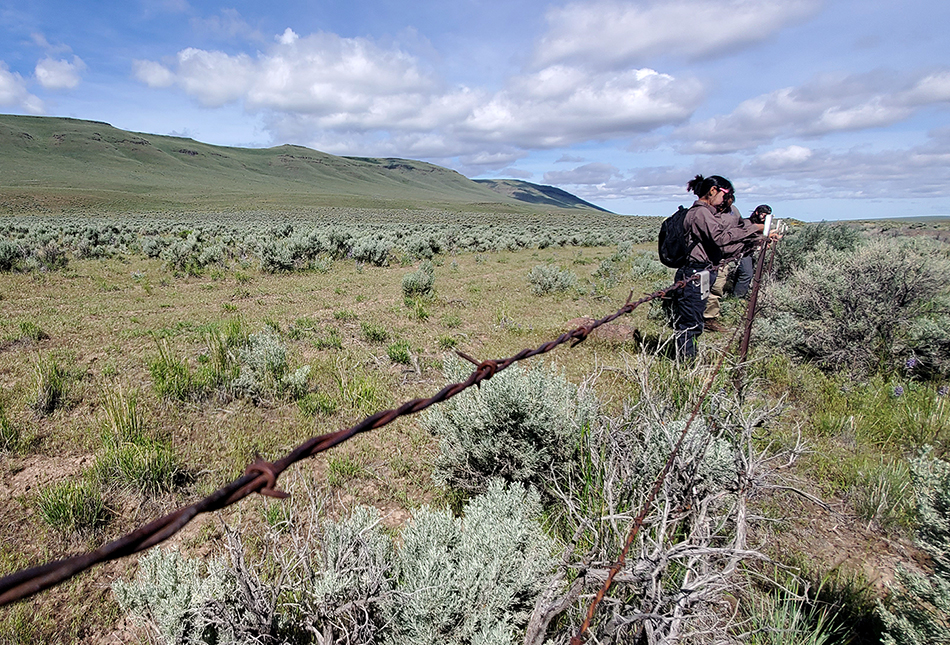Visiting Oregon’s high desert for the first time can leave a lasting impression on people. Those people can also make a positive impact on its future. Both happened in spring when Tribal youth assisted in fieldwork meant to inspire the next generation of Tribal land stewards.
Out-of-state camping trips are common in summer, but most people don’t work during them. We were fortunate to host a camping crew of dedicated teenagers who were new to the high desert and came specifically to help it. In June, the Tribal Stewards Inclusion Crew joined us in conservation work at Trout Creek Ranch. In only a few days, 11 people who had never been to Oregon’s high desert made parts of it better.
This was a goal of Northwest Youth Corps’ Tribal Stewards program. It focuses on leadership development for Tribal youth with the guidance and mentorship of trained conservation professionals. Elements include connecting with Tribal homelands, cultural and natural resource education, professional development and supporting fitness through conservation work. Emphasis is placed on holistic development and on the premise that healthy land supports healthy people.
A conservation plan has been established for Trout Creek Ranch and includes floodplain restoration and future plantings along Trout Creek at the ranch headquarters. To begin the week, the crew assisted Andy Gray, our Trout Creek Ranch stewardship lead, and Brandon Palmer, regional stewardship lead, in beginning the takedown of the north portion of the former feedlot. Next up was removing noxious weeds and cleaning out loading chutes. Greater sage-grouse are vulnerable to flying into fence lines, so the crew also installed nearly two miles of fence markers near the Pueblo Mountains to help the birds see the fences better at night and in the snow.
Trout Creek Ranch is near Fields, Oregon and on the traditional homelands of the Numu People, who are commonly known as Northern Paiute. They have been stewards of this land since time immemorial and the high desert continues to be important to them. Many communities were tragically displaced during European settlement and now live on reservations and in other communities across the Northwest that are far from their ancestral lands. Paiute elders of the Fort McDermitt Paiute Shoshone Tribe came to share historical, cultural and personal histories with the Tribal Stewards. Their Tribe includes Northern Paiute and Western Shoshone peoples whose reservation spans a region along the Nevada, Oregon and Idaho borders.
Tribal Steward Crew members came from Washington, Montana, Nebraska, South Dakota and Arizona. They traveled from the Oregon coast to the high desert with Northwest Youth Corps. This Eugene-based organization educates and engages young people by teaching them important life skills that also have positive effects on the natural environment.
The Tribal Stewards includes 16- to 18-year-olds who participate in seven weeks of outdoor projects and receive financial stipends and education credits for their efforts. With the guidance of experienced field staff, youth crew members work on conservation, reforestation, and recreation projects throughout the Northwest while developing leadership skills and learning how to work as a team. Crews typically camp in the field for their entire session, traveling to new projects every week. We were fortunate that Trout Creek Ranch was on their path before they headed north to Malheur National Wildlife Refuge.
“Education every day,” is something that Anna McCormick values in their programs. She’s proud of the impact they have on youth and partners, both personally and professionally. Anna originally joined for one season in 2021 and thought that would be it. She’s now a program coordinator who supports crew leaders in the field. She also enjoys assisting as a woodsboss for the Community Wildfire Protection Corps to help others learn about tools and community engagement.
Audie Davis (Chinook Tribe) also started in a field crew and advanced to being a team leader who transports his crews across the Pacific Northwest. He shared that he loved seeing and exploring this slice of the world and even envisioned living and working on the ranch after the program.
The small crew enjoyed being outdoors, with some members explaining how they couldn’t be cooped up inside and couldn’t imagine ever working in an office or a cubicle. That said, while camping was planned during their third week, they enjoyed some housing options at Trout Creek Ranch. Many were grateful to sleep and shower indoors, and to stock some food in a fridge halfway through their session. “It really was a motivator,” felt Jordan Andrews of Washington (Skokomish). This was Jordan’s second time in the program and she was eager to complete a full season this time. “This is a step forward. It’s gonna be a positive thing,” she said.
Jordan enjoyed helping in conservation work outdoors and learning about the different flora and fauna of each area. The same held for Celeste Crocker of Arizona (White Mountain Apache and Gila River Pima), who was also on her second season. They’d taken part in a good deal of restoration and yard work and were happy to add markers to a long fenceline in the desert to support sage-grouse, hundreds of miles from where they started the program. Celeste also enjoyed collecting wildflowers along the way to sketch and identify later in the day.
The work came easy, as did discussing their career plans, which involved helping others. They also worked quietly within the Pueblo Mountains, taking in the light breeze and their remoteness among hills of sagebrush that rolled on for miles. “This is freedom for me,” Jordan shared of the program.
With the seventh week complete, members have now gone their separate ways across the West. We hope Trout Creek Ranch continues to be on their path next year, and those that follow. Although the team’s stay wasn’t long, their efforts helped people and wildlife for many seasons to come.








